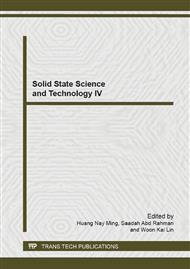p.25
p.29
p.35
p.41
p.45
p.51
p.57
p.63
p.71
Formation and Optical Studies of Porous GaN Thin Films via UV-Assisted Electrochemical Etching Approach
Abstract:
This paper presents the investigation of porous gallium nitride (PGaN) thin films by ultra-violet (UV)-assisted electrochemical etching at various etching durations. The etching process was performed in potassium hydroxide aqueous solution under illumination of 150 W xenon lamp. The surface morphology and cross-section of the PGaN thin films were examined by scanning electron microscopy. Increased etching duration resulted in a more homogeneous pore distribution. Results showed that the etching duration strongly influences the layer characteristic of porous structure. Infrared (IR) and Raman studies were performed to investigate the optical properties of PGaN. IR spectroscopy revealed that the PGaN thin films exhibit distinctive IR spectra as compared to the as-grown GaN thin film. The number of interference fringes in the non-reststrahlen band is correlated to the film thickness of as-grown and PGaN thin films. The Raman measurements clearly reveal two forbidden optical phonon modes observed in all the PGaN thin films. This result indicates the crystal disordering in the films. Additionally, the findings show that the intensity of these forbidden modes becomes stronger with increasing etching duration.
Info:
Periodical:
Pages:
45-50
Citation:
Online since:
February 2014
Price:
Сopyright:
© 2014 Trans Tech Publications Ltd. All Rights Reserved
Share:
Citation:


